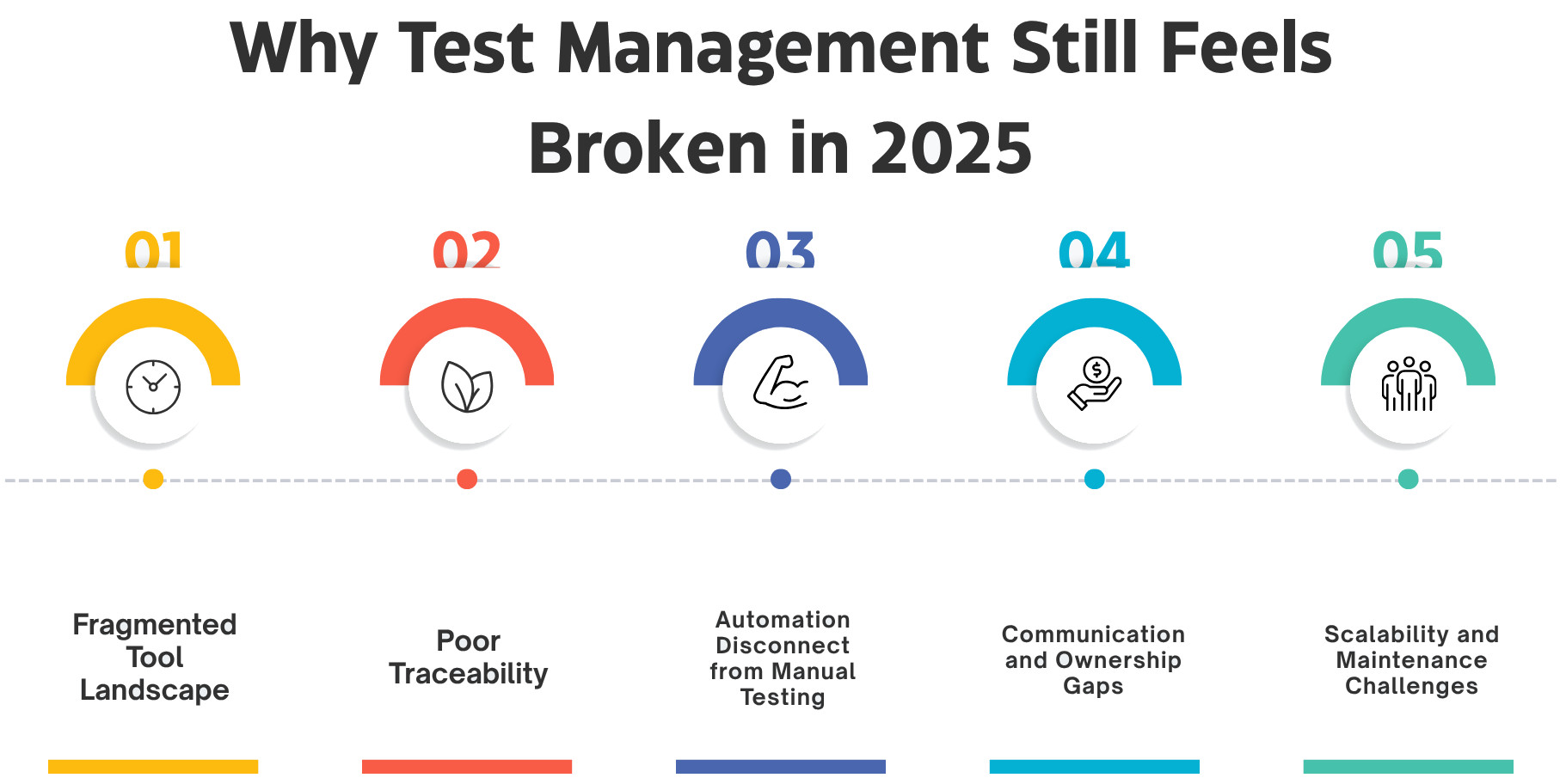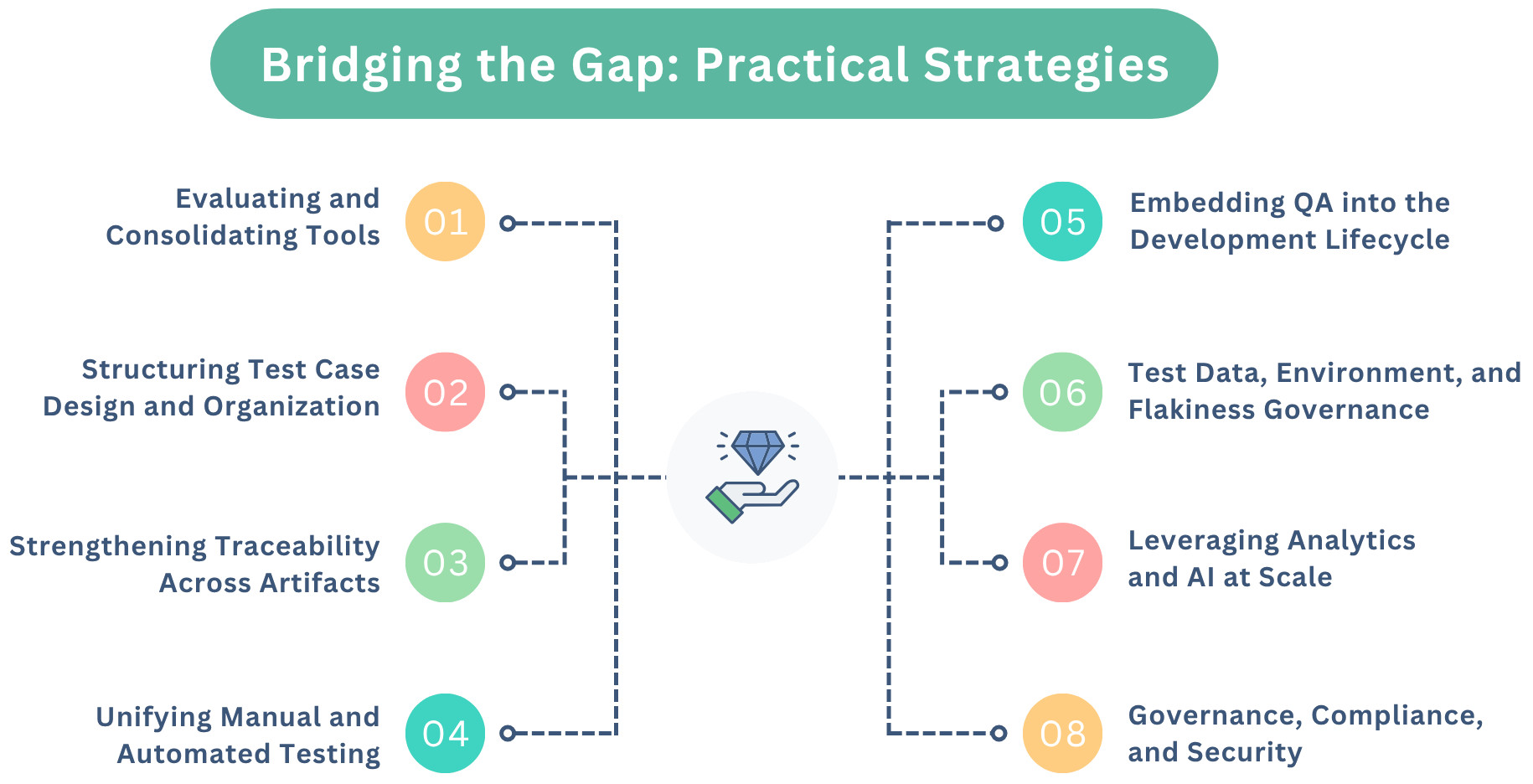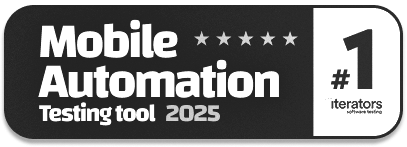How to Make Broken Test Management Cohesive in 2025?
|
|
Test management is a requisite phase of the software development lifecycle ( SDLC ), which imparts quality assurance and unity to the end product. Nevertheless, broken and disconnected test management processes are some of the pitfalls experienced by many organizations. Such problems as tool fragmentation, incompatible communication, and team integration deter efficiency and augment the threat of failures. It becomes even more critical to automate test management in 2025, as agile methodologies, DevOps practices, and more sophisticated AI-based application environments can grow.
| Key Takeaways: |
|---|
|

Why Test Management Still Feels Broken in 2025

Even in 2025, despite the persistence of developing better testing solutions and their use, numerous companies continue to find it difficult to establish an integral test administration plan. There are a number of causes of this particular problem that make test management seem shattered.
- Fragmented Tool Landscape: Fragmentation of test management tools across organizations has become one of the greatest concerns today. Many testing platforms exist, with each one targeting specific types of tests (e.g., unit, integration, UI). This makes it difficult to establish a coherent testing system. Since these tools are not always well integrated, testing activities often become siloed.
- Poor Traceability: Traceability, or the capacity to track test cases from requirements to defects, is usually poor in most organizations. Lack of proper traceability tempers teams’ understanding of how to relate requirements, test cases, and defects. With testRigor, traceability becomes seamless as tests are tied to user stories, requirements, and defects in natural language. This makes it easier for stakeholders to follow a requirement’s lifecycle from conception to validation without technical barriers. Read more: Requirement Traceability Matrix RTM: Is it Still Relevant?
- Automation Disconnected from Manual Testing: Although there has been enough growth in the automation of tests, most organizations have not been successful in implementing automated tests side by side with manual testing activities. This lack of integration will imply that tests are not run in tandem, and there is a lack of integration between tests that carry out the entire testing process.
- Communication and Ownership Gaps: The broken test management comes as a result of communication failure between the teams (development, QA, and product). Lack of accountability and communication usually results in certain test areas being missed despite having key elements included in the overall test planning and implementation.
- Scalability and Maintenance Challenges: As software products grow in size and complexity, the scalability and maintenance of test management systems become increasingly important. Managing operations at the level of thousands of tests and the software’s variability demands powerful tools and well-structured processes. Read how to Decrease Test Maintenance Time by 99.5% with testRigor.
Envisioning Cohesive Test Management in 2025

The future of software development and testing is transforming very fast as we end 2025. To repair the unimagined, untidy, and fragmented practices of test management, organizations must have a vision of a more integrated practice. This is aimed at making sure that testing is not a scramble but a part of the software development lifecycle.
1. Unified Quality Workflow
A single quality workflow will ensure that the test is a seamless part of the development cycle and will enhance interaction and facilitate the process. This is the process of seeing to the various stages of development, testing, and deployment occur in a way of feedback progression.
- Unified Pipeline: Testing is one of the steps of a pipeline within the CI/CD process to apply continuous testing and timely feedback.
- Cross-functional Teams: This promotes a closer co-ordination between product teams, testers as well as development teams that define/ specify quality goals.
- End-to-End Testing: This is a platform that combines unit, integration, functional, and non-functional testing into one sequence that, in the process, will cover all product facets.
Tools like testRigor help unify fragmented testing efforts by allowing teams to write tests in plain English, covering UI, API, and end-to-end flows in one platform. Instead of juggling multiple tools for different test types, teams can centralize efforts, making the workflow more cohesive.
Seamless Integration Across Tools and Teams
The integration plays a leading role in eliminating silos that are inherent with regard to test management. It is with the assistance of organization, through teamwork and technology, that organizations can make testing seem more cohesive and pace-charged.
- Tool Integration: It involves choosing tools that are highly integrated and thus promote automatic data exchange between systems in performing test administration and when being used in bug tracking and version control. Read here about testRigor integrations.
- Cross-team Communication: Development of a definite protocol and channels among the teams of development, QA, and operations to achieve the sharing of insights and the solving of issues on a timely basis.
Balanced Manual-Automated Testing Strategy
The proposed test management strategy should moderate the implementation of automated testing and manual testing to bring about a balanced coverage of both testing methods, but still remain cost-effective. A balance will allow the organizations to minimize testing and incur minimal costs.
- Manual Testing to Exploratory Testing: The technique enables manual testers to specialize in that portion of the test where human feeling and imagination are vital, such as user experience testing or exploratory testing.
- Test Automation Frameworks: Laying down money on reusable and scalable automation frameworks is helpful at a supreme level.
Scalable and Sustainable Test Hygiene
During the development of software projects, it becomes important to have an illustrated test suite that is clean, scalable and sustainable. Test hygiene is defined as the art of renewing and maintaining the test suite every now and again to make them remain up to date and efficient.
- Common Test Maintenance: Keep a regular check on the tests and delete outdated or redundant cases so as to maintain a lean and efficient test suite. testRigor’s AI-powered self-healing capabilities dramatically reduce maintenance overhead by automatically adapting tests when UI changes occur. This keeps test suites lean, up-to-date, and scalable even in large projects.
- Modular Test Design: Arranging tests in a loose manner to ensure that they are easier to change, sustain, and expand.
AI, Analytics, and Predictive Insights
Data analytics and Artificial Intelligence (AI) can revolutionize the process of test management by providing predictive power and automated devices. Such technologies give the organizations better chances to anticipate possible problems and manage their tests, producing superior output.
- AI-based Test Automation: Developing high-risk areas through AI and producing tests through historical data.
- Predictive Analytics: Utilizing data analytics to show the potential chances of a defect, giving the opportunity to identify the possible problem in the initial stages. Read: Predictive Analytics in Software Testing.
- Test Optimization: Artificial Intelligence improves AI-assisted programs to recommend the most important tests to be executed as per the code change to achieve the best efficiency in test execution and test coverage.
Governance, Compliance, and Auditability
As test management becomes more complex, it is high time to provide effective governance, compliance and auditability. This will place the test practices on the same level as the regulation requirements, and the organizations will have the capacity to track the test activities as responsibly.
- Clear Documentation: This pertains to maintaining accurate records of the test procedures, test outcome, as well as the judgment in order to provide accountability.
- Audit Trails: It entails placing audit systems to capture all the test activities in order to make use of tracking test processes.
2. Evaluating and Consolidating Tools
Bridging the gap between speed, quality, and collaboration requires practical strategies that align testing with broader development goals. By consolidating tools, strengthening traceability, unifying manual and automated efforts, and embedding QA throughout the lifecycle, teams can ensure both efficiency and quality. Tool consolidation is essential in order to facilitate testing processes. It makes the sometimes-complex task of testing tools, or a network of tools, effectively managed within one platform.
Assessing the Current Toolset
When using tool consolidation, the first step is to analyze the tools themselves. This will enable teams to know which are functioning and which are not.
- Compare the frequency of use as well as the level of effectiveness of each of the tools in the testing process. This will assist it in determining which tools are providing value and which are not performing as expected.
- Define areas of any unmet functions in the modern tools that might not fulfill the testing needs, and which test features are missing.
Defining Ideal Tool Requirements
As per the assessment, the next stage is to define the new toolset features that need to be proposed to the list. Such requirements are supposed to be consistent with the organization’s testing goals.
- Integrate the new tool with other existing tools, i.e. include CI/CD pipelines, version control, and bug tracking. This will play a big role when it comes to harmonious cooperation.
- As an illustration, the tool must be scaled and capable of meeting the rising demands of the staff and also addressing the complexity of the project development as it rises.
3. Structuring Test Case Design and Organization
Good design and organization of test cases ensure that the tests can be easily handled, scaled, and follow a proper plan in which the test is coordinated with the overall testing strategy.
Feature-Driven Organization of Tests
It is good to organize tests with respect to features of products in order to keep them valuablet and make sure that every feature is comprehensively tested.
- Functional partitioning of groups.
- Eliminates the testing disconnects between features.
- It focuses on feature-specific tests, hence simplifying the maintenance process.
Reuse and Parameterization to Reduce Duplication
Reuse and parameterisation is certain to provide effective testing because the redundancy is minimised and maintenance work is drastically reduced.
- Test cases are reused, and test case steps are reduced.
- Duplication and redundancy of tests are destroyed.
4. Unifying Manual and Automated Testing
Integrating manual and automated testing would provide complete test coverage and reduce feedback. It supports a team in both forms of testing, to the advantage of enhanced testing quality.
Shared Dashboards for Execution
The outcomes of the manual and automated tests are displayed in a single dashboard where everyone is in a better position to see all the results and track the outcomes. It allows teams to track the state of tests and defects as well as the general progress in real times.
Examples:
- An automated and a manual testing dashboard.
- Test managers have a common dashboard, through which they prioritize defects in both manual and automated testing.
CI/CD Orchestration of Automated Suites
The combination of automated test suites into CI/CD pipelines leads to automated testing being performed whenever a piece of code is deployed or saved in the repository. This makes it possible to have continuous feedback and therefore, the developers realize early when something has gone wrong, and the release process is eventually fast.
Examples:
- CI pipeline, including automated unit tests, is set up to identify problems early on in the code and run them at every code push.
- Performance tests are triggered automatically during deployment to determine the bottlenecks.
Hybrid Testing Workflows and Shift-Left Mindset
Hybrid testing processes combine the power of manual and automated testing. Testing early in the cycle of development, or a shift-left mentality, focuses on making the development process aware of how to detect failures at earlier stages and save cost and time in subsequent phases.
5. Embedding QA into the Development Lifecycle
Enhancing the development lifecycle at the earliest stage of the development process will make sure that quality will be one of the priorities. This will minimize the number of defects and enhance the final quality of the products. It promotes teamwork and assists groups in making testing activities consistent with development objectives.
Early Involvement in Planning and Grooming
Early QA planning and grooming activities contribute to the better coverage of tests by identifying potential issues and delaying them down early, to prevent their occurrence.
- Collaborative Requirement Review: QA assists in the identification of the test cases and possible risks during the stage of requirement gathering.
- Serious Planning: QA is able to lay out testing plans and design the resources/environment/data that will be required in advance of the development.
Shared Visibility and Accountability Across Teams
Being at the same level of visibility means that everybody on the team is geared towards a common direction in goals and duties, and becomes more collaborative and accountable in the project.
- Cross-team Collaboration: Team members, developers, testers, and product managers can access the same test and development data.
- Shared responsibility: Development and QA teams have quality ownership, which causes no dysfunctions and this results in fewer defects.
6. Test Data, Environment, and Flakiness Governance
Correctly managing test data, environments, and flaky tests will guarantee consistency, reliability, and quicker issue resolution during testing.
Stable and Reproducible Environments
Replicable test environments also ensure the consistency of test results, making sure they do not fail on account of the environment.
- It guarantees an identical environment during testing and development.
- Lessons can be learned from inconsistencies in test results.
- Ensures that it is easy to repeat test failures.
Flaky Test Tracking and Test Isolation
The test isolation and tracking of flaky tests would make sure that the tests do not block good tests in the CI/CD loop. False outcomes can be avoided by running flaky tests at a time.
Data Management for Repeatable Testing
The test data is handled adequately for identical and repeatable tests, which enhances test result accuracy.
- Use of similar datasets in each test cycle.
- Measures taken to refresh test data.
- Ensures reliable and stable testing.
7. Using Analytics and AI at Scale
Analytics and AI in testing allow scalability (help teams scale their efforts) and provide optimal test coverage that makes testing more efficient and faster. It allows for making more intelligent improvements and increases the quality of the product.
Test Coverage and Gap Analysis
The analytics can be established to determine the part of the application that was not subjected to the test, so that the majority of the critical features are properly tested.
- Find Uncovered Gaps: Tools trace and point to untested areas of the application.
- Prioritize Testing: Prioritize testing requirements in high-risk areas.
Predictive Testing and Risk-Based Prioritization
AI can rank risky application sections so that the teams can concentrate on testing them.
- Possible dangers, or their indicators: Anticipate what will go wrong in the future by observing how they occurred in earlier periods.
- Test Concentration: Emphasis should be placed on tests in risky areas to determine serious issues in the early stages.
8. Governance, Compliance, and Security
Governance, compliance, and security practices maintain the integrity and reliability of test data, environments, and processes and guarantee that test artifacts comply with industry standards and requirements.
Role-Based Access Control (RBAC)
RBAC will make sure that only authenticated people can access certain resources according to their position.
- Role-based granular permissions.
- Eliminates unauthorized access to sensitive information.
- Keeps a record of activities taken by users according to roles.
Audit Trails and Change Logs
Audit trails, along with change logs are used to trace all operations carried out in the testing process in order to be transparent and compliant.
- Changes to test cases and data.
- Keep a record of what is done to stay accountable.
- Assists in determining times and causes of problems.
Challenges in Achieving Cohesive Test Management
- Resistance to Change: Resistance to change often arises from mindsets where employees feel comfortable with old processes and fear the uncertainty of new ones. A lack of awareness about the benefits of new tools, combined with the challenge of driving a cultural shift, makes adopting change a gradual and complex process.
- Tool Adoption and Training Difficulties: Successful tool adoption depends on proper training, strong onboarding, and ongoing support. Without these, steep learning curves and weak guidance can hinder adoption, while continuous learning ensures teams gradually master new tools during the transition.
- Balancing Speed with Quality Governance: In agile environments, it’s crucial to balance speed with thorough testing and quality assurance. While rushing can lead to shortcuts and defects, implementing strong quality governance and using clear testing frameworks enables teams to maintain high standards without slowing delivery.
Wrapping Up
In 2025 and beyond, cohesive test management is no longer optional; it is a necessity for organizations striving to keep up with rapid release cycles and complex environments. By consolidating tools, embedding QA early in the lifecycle, and balancing manual with automated testing, teams can reduce silos and inefficiencies.
AI-powered platforms like testRigor further strengthen this cohesion by providing natural language test creation, self-healing capabilities, and unified support for end-to-end testing. Ultimately, organizations that adopt such integrated approaches will achieve not only speed and scalability but also sustained quality and resilience in their software delivery.
| Achieve More Than 90% Test Automation | |
| Step by Step Walkthroughs and Help | |
| 14 Day Free Trial, Cancel Anytime |












